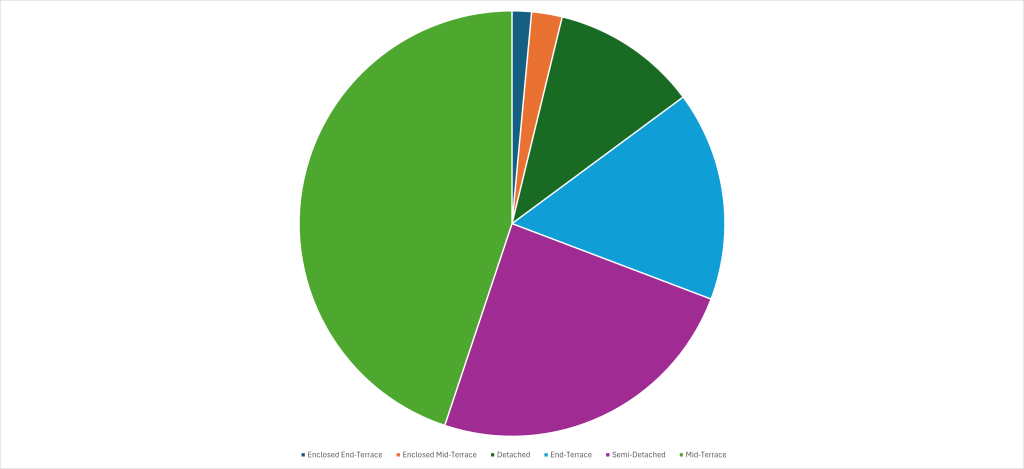
The detachment style of private rented sector (PRS) properties significantly impacts their energy efficiency potential and ability to meet EPC rating requirements. Recent data from Swansea’s PRS highlights the distribution of detachment styles and provides insights into the challenges and benefits associated with each type. This article explores these factors and offers guidance for landlords aiming to improve their properties’ energy performance.
Distribution of PRS Properties by Detachment Style
The breakdown of PRS properties in Swansea by detachment style reveals the following:
- Enclosed End-Terrace: 309 properties (1.455%)
- Enclosed Mid-Terrace: 487 properties (2.292%)
- Detached: 2,327 properties (10.954%)
- End-Terrace: 3,344 properties (15.741%)
- Semi-Detached: 5,116 properties (24.082%)
- Mid-Terrace: 9,432 properties (44.398%)
Mid-terrace properties dominate the PRS housing stock, comprising 44.398% of the total. In contrast, detached homes account for only 10.954%, while enclosed terrace properties are relatively rare.
Energy Efficiency Implications by Detachment Style
The number of external walls a property has is a key factor in determining its heat loss potential and, consequently, its energy efficiency. Properties with fewer external walls generally perform better thermally and are easier to upgrade to higher EPC ratings.
Mid-Terrace Properties
Mid-terrace homes benefit from having two shared party walls with neighbouring properties, which significantly reduces their exposed surface area. This inherent design advantage helps retain heat and often makes mid-terrace properties one of the easiest to upgrade to EPC C. However, other factors, such as loft insulation and window glazing, still play an essential role in their overall energy performance.
End-Terrace and Enclosed Terrace Properties
End-terrace properties, with three external walls, experience greater heat loss compared to mid-terrace homes. Enclosed terrace properties, which are surrounded by other structures on three or more sides, have a thermal advantage but may still require targeted upgrades, such as improved roof or ground floor insulation, to achieve compliance with EPC standards.
Semi-Detached Properties
Semi-detached properties have one shared party wall, leaving three external walls exposed to heat loss. Achieving EPC C in these homes often requires significant investment in wall insulation, as well as attention to windows, doors, and loft spaces. Retrofitting semi-detached homes is more challenging compared to mid-terrace properties but still achievable with a comprehensive energy efficiency plan.
Detached Properties
Detached homes are the most thermally exposed, with all external walls contributing to heat loss. Without substantial retrofitting measures, such as external wall insulation or advanced glazing, these properties can struggle to meet EPC C requirements. Detached homes typically require the most extensive upgrades due to their design.
The Importance of Wall Insulation
For properties with high external wall exposure, wall insulation is a critical measure for improving energy efficiency. Cavity, External or internal wall insulation can significantly reduce heat loss and improve a property’s EPC score. For older properties, such as those with solid brick or stone walls, retrofitting insulation is essential to achieving higher energy performance.
Conversely, properties with shared walls, such as mid-terrace homes, may achieve higher EPC ratings with fewer interventions. These properties can focus on other measures, such as upgrading heating systems or improving loft and floor insulation, to further enhance their energy efficiency.
Planning for EPC C and Beyond
The detachment style of a property is a critical consideration for landlords aiming to meet EPC targets. Understanding the thermal dynamics of each detachment style allows for more strategic planning of energy efficiency upgrades.
For mid-terrace properties, achieving EPC C may require only modest investments, such as loft insulation or boiler upgrades. For semi-detached and detached homes, a more comprehensive approach is necessary, focusing on wall insulation and other measures to address heat loss through external surfaces.
Conclusion
The detachment style of PRS properties in Swansea plays a significant role in determining their energy efficiency and ease of upgrading to higher EPC ratings. Mid-terrace properties, with their shared party walls, offer the greatest thermal advantage, while detached and semi-detached homes require more extensive retrofitting to achieve compliance.
By understanding the specific challenges and opportunities associated with each detachment style, landlords can prioritize energy efficiency measures effectively. This targeted approach not only improves EPC ratings but also enhances tenant comfort and contributes to reducing carbon emissions across Swansea’s housing stock.